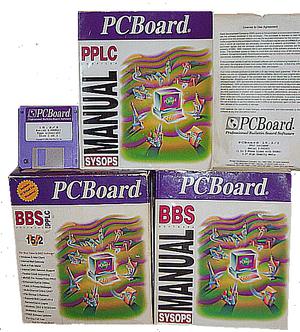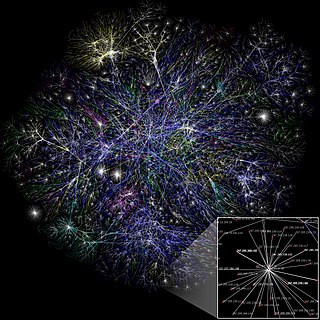FidoNet is a worldwide computer network that is used for communication between bulletin board systems (BBSes). It uses a store-and-forward system to exchange private (email) and public (forum) messages between the BBSes in the network, as well as other files and protocols in some cases.
The Internet protocol suite, commonly known as TCP/IP, is a framework for organizing the set of communication protocols used in the Internet and similar computer networks according to functional criteria. The foundational protocols in the suite are the Transmission Control Protocol (TCP), the User Datagram Protocol (UDP), and the Internet Protocol (IP). Early versions of this networking model were known as the Department of Defense (DoD) model because the research and development were funded by the United States Department of Defense through DARPA.
The Transmission Control Protocol (TCP) is one of the main protocols of the Internet protocol suite. It originated in the initial network implementation in which it complemented the Internet Protocol (IP). Therefore, the entire suite is commonly referred to as TCP/IP. TCP provides reliable, ordered, and error-checked delivery of a stream of octets (bytes) between applications running on hosts communicating via an IP network. Major internet applications such as the World Wide Web, email, remote administration, and file transfer rely on TCP, which is part of the Transport layer of the TCP/IP suite. SSL/TLS often runs on top of TCP.

In computer networking, the transport layer is a conceptual division of methods in the layered architecture of protocols in the network stack in the Internet protocol suite and the OSI model. The protocols of this layer provide end-to-end communication services for applications. It provides services such as connection-oriented communication, reliability, flow control, and multiplexing.
UUCP is a suite of computer programs and protocols allowing remote execution of commands and transfer of files, email and netnews between computers.
AX.25 is a data link layer protocol originally derived from layer 2 of the X.25 protocol suite and designed for use by amateur radio operators. It is used extensively on amateur packet radio networks.
ZMODEM is an inline file transfer protocol developed by Chuck Forsberg in 1986, in a project funded by Telenet in order to improve file transfers on their X.25 network. In addition to dramatically improved performance compared to older protocols, ZMODEM offered restartable transfers, auto-start by the sender, an expanded 32-bit CRC, and control character quoting supporting 8-bit clean transfers, allowing it to be used on networks that would not pass control characters.
In computer network research, network simulation is a technique whereby a software program replicates the behavior of a real network. This is achieved by calculating the interactions between the different network entities such as routers, switches, nodes, access points, links, etc. Most simulators use discrete event simulation in which the modeling of systems in which state variables change at discrete points in time. The behavior of the network and the various applications and services it supports can then be observed in a test lab; various attributes of the environment can also be modified in a controlled manner to assess how the network/protocols would behave under different conditions.
WWIV was a brand of bulletin board system software popular from the late 1980s through the mid-1990s. The modifiable source code allowed a sysop to customize the main BBS program for their particular needs and aesthetics. WWIV also allowed tens of thousands of BBSes to link together, forming a worldwide proprietary computer network, the WWIVnet, similar to FidoNet.
MPEG transport stream or simply transport stream (TS) is a standard digital container format for transmission and storage of audio, video, and Program and System Information Protocol (PSIP) data. It is used in broadcast systems such as DVB, ATSC and IPTV.

PCBoard (PCB) was a bulletin board system (BBS) application first introduced for DOS in 1983 by Clark Development Company. Clark Development was founded by Fred Clark. PCBoard was one of the first commercial BBS packages for DOS systems, and was considered one of the "high end" packages during the rapid expansion of BBS systems in the early 1990s. Like many BBS companies, the rise of the Internet starting around 1994 led to serious downturns in fortunes, and Clark Development went bankrupt in 1997. Most PCB sales were of two-line licenses; additional line licenses were also available.

The Bhutan Broadcasting Service is a state-funded radio and television service in Bhutan. A public service corporation which is fully funded by the state and it is the only service to offer both radio and television in the kingdom, and is the only television service to broadcast from inside the Bhutanese border. The use of telecommunications is currently governed through the Information, Communications and Media Act of 2006.
IP multicast is a method of sending Internet Protocol (IP) datagrams to a group of interested receivers in a single transmission. It is the IP-specific form of multicast and is used for streaming media and other network applications. It uses specially reserved multicast address blocks in IPv4 and IPv6.
PACTOR is a radio modulation mode used by amateur radio operators, marine radio stations, military or government users such as the US Department of Homeland Security, and radio stations in isolated areas to send and receive digital information via radio.
Q15X25 is a communications protocol for sending data over a radio link. It was designed by amateur radio operator Pawel Jalocha, SP9VRC, to be an open communications standard. Like all amateur radio communications modes, this protocol uses open transmissions which can be received and decoded by anyone with similar equipment. Q15X25 is a form of packet radio. It can be used to interconnect local VHF AX.25 packet networks over transcontinental distances. Anyone can design or adapt the open-source software to develop their own Q15X25 system.

A computer network is a set of computers sharing resources located on or provided by network nodes. Computers use common communication protocols over digital interconnections to communicate with each other. These interconnections are made up of telecommunication network technologies based on physically wired, optical, and wireless radio-frequency methods that may be arranged in a variety of network topologies.
Winlink, or formally, Winlink Global Radio Email, also known as the Winlink 2000 Network, is a worldwide radio messaging system that uses amateur-band radio frequencies and government frequencies to provide radio interconnection services that include email with attachments, position reporting, weather bulletins, emergency and relief communications, and message relay. The system is built and administered by volunteers and is financially supported by the Amateur Radio Safety Foundation.

SoftEther VPN is free open-source, cross-platform, multi-protocol VPN client and VPN server software, developed as part of Daiyuu Nobori's master's thesis research at the University of Tsukuba. VPN protocols such as SSL VPN, L2TP/IPsec, OpenVPN, and Microsoft Secure Socket Tunneling Protocol are provided in a single VPN server. It was released using the GPLv2 license on January 4, 2014. The license was switched to Apache License 2.0 on January 21, 2019.





